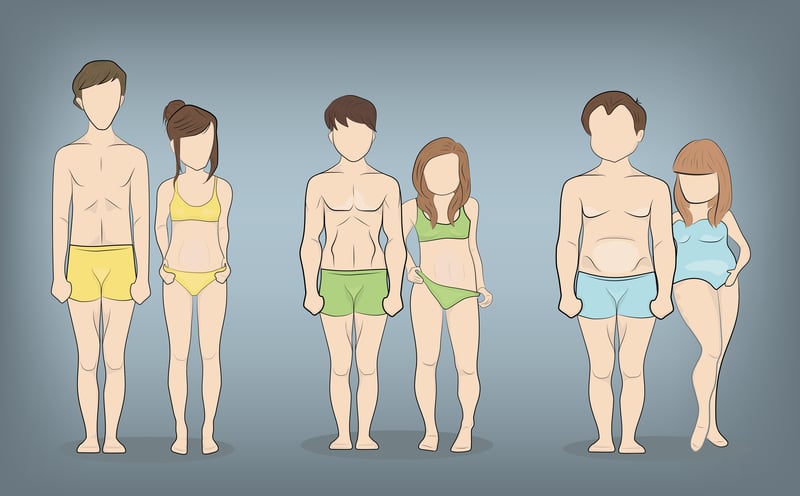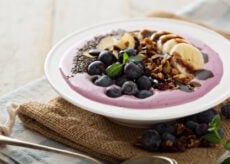What is Your Metabolic Body Type (and how to cater to it)

Even the quickest glance around your gym or grocery store, office or neighborhood will reveal numerous sizes and shapes when it comes to people’s bodies. Of course, much of that depends on various lifestyle choices. Yet there’s also a genetic component. Looking at your own body, have you ever wondered what your metabolic body type is and if it makes a difference in how you train and eat?
Metabolic body type proponents suggest your specific body type does indicate how you process carbohydrates, how much protein you need, and how eating and exercise can influence your metabolism and hormones.
In other words, there may be adjustments you can make to help you optimize your diet, your workouts, and your routines to better suit your metabolic body type.
What are the Metabolic Body Types?
There are three main metabolic body types (aka somatotypes), which are defined by how the body converts energy into movement and functioning. These include mesomorph, ectomorph, and endomorph. However, there are also mixed body types. That is, many people appear to have a combination of two body types.
So, if you feel like your body doesn’t fit one type completely, that isn’t unusual. When choosing the best diet or activities for your body type, you may need to mix and match to find what works best for you and your unique body.
Now that you know the three main body types, let’s get into how they’re categorized:
1. Ectomorphic Metabolic Body Type
Folks with this body type tend to be slimmer with smaller joints and lighter builds. A typical ectomorph may be taller, look thinner, have more narrow shoulders and a smaller chest, lack muscle mass, be more fidgety or show signs of hyperactivity, and find it harder to gain weight.
It can be tough to gain muscle if you’re predominately this body type, as you have a faster metabolism. This, however, isn’t always a blessing. Yes, it may be easier to get lean, even without being super strict with your diet. But over time (e.g., with age), especially if you lose muscle mass, body fat can creep up on you. While many people think ectomorphs are skinny, even if they look slim when fully dressed, some ectomorphs can struggle with too much body fat, sometimes referred to as “skinny fat.”
In other words, being an ectomorph doesn’t determine body fat levels. Overall calories and diet, exercise, and activity levels do.
Nutrition and Training for Ectomorphs
Many things go into how to eat for any individual, so your needs may be different. In general, however, recommendations include:
- Starting the day with a healthy, well-balanced breakfast.
- Ensuring you eat enough of all macronutrients (protein, carbs, and fats).
- For those who struggle to gain weight, it can help to eat throughout the day and enjoy more carbohydrates (up to ~50 to 60% of calories) than other body types. However, the typical recommended macronutrient split for ectomorphs is 45% carbs, 35% protein, and 20% fat.
- Refueling the body after exercise with quality protein and healthy whole carbohydrates, including whole grains, nuts, seeds, vegetables, and fruits.
- Incorporating strength training in your workout program at least three days per week and focusing on progressively more challenging weights to gain strength and muscle size. Workouts may be even more productive if you choose heavy, slow sets and give the body longer to recover between each set.
- Not forgetting cardio workouts as heart health is important. But strength workouts are the star of the show unless you’re an endurance athlete (e.g., marathoner).
- Leaning toward heavier weights and more compound (rather than isolation) moves. It may take longer for ectomorphs to gain muscle, but with consistent effort, they can begin to look more fit and toned.
2. Mesomorph Metabolic Body Type
People with more athletic (but not bulky) builds who gain muscle fairly easily are considered mesomorphs. While they tend to naturally have more athletic frames, they may be more likely to take their bodies for granted, which can lead to weight gain. They may, however, continue to look more athletic due to enjoying broad shoulders, stronger muscles, and a medium-size frame. These individuals can respond well (and quickly) to exercise. But they may also carry more body fat, especially on the lower body, including the butt and thighs.
Nutrition and Training for Mesomorphs
Again, it’s important to scale for your own individual differences. But in general, recommendations for mesomorphs include:
- Eating healthy whole foods, including a good balance of all macronutrients. For carbohydrates in general, focus on more plant-based, high-fiber options like potatoes, legumes, whole grains, and fruits and limit refined sugars and flours.
- Eating protein with each meal and avoiding too much fat. For example, Mesomorphs may do well on a 40% carbohydrate, 30% protein, 30% fats diet.
- Cutting back on processed foods, especially if the goal is to lose weight or body fat.
- Enjoying an equal mix of cardio and strength training, including high-intensity activities like HIIT or plyometric exercise to take advantage of your more athletic build. Regularly challenge your body for greater results, but watch out for doing too much cardio or endurance training, as it may lead to a loss of muscle mass as well as fat.
RELATED: Collagen Doesn’t Work (Unless…)
3. Endomorph Metabolic Body Type
The final body type is the endomorph. These folks tend to have larger bone and joint structures but can also carry the most body fat as they’re the most efficient body type for storing, rather than burning, energy. They can also carry a good amount of muscles, tend to have thicker arms and legs, and can gain muscle (and strength) quickly. But they can also carry more fat around the belly and tend to appear more rounded, physically.
Nutrition and Training for Endomorphs
Again, these folks may find losing weight and fat more difficult due to slower metabolisms and less endurance. That is, they may find they get fatigued faster than other body types. Yet they can also develop really strong, powerful, healthy bodies. General recommendations include:
- Limiting carbohydrates, especially refined ones, and choosing healthy whole-food vegetables, fruits, and whole grains to help them fill up on fiber and reduce appetite and calorie load.
- Choosing foods that have a lower impact on blood sugar levels and provide lasting fuel to help maintain higher energy levels, including more quality protein sources and healthy fats. Good choices include fish, healthy oils, avocados, and nuts, which can decrease hunger and boost energy.
- Watching out for high-calorie foods and keeping calories in check. Some experts recommend lower-carb diets like paleo and keto-inspired plans. An often-recommended macro split for endomorphs is 20% carbs, 40% protein, and 40% fats.
- Incorporating cardio into strength workouts, such as with intervals or circuits to help the body torch more calories.
- Lifting moderate to heavy weights using compound movements with short rest periods to build strength and muscle mass quickly.
- Once you’ve increased fitness levels, choosing high-intensity interval workouts like HIIT over slow-go cardio to get the most bang for your buck and upgrade your metabolism.
- Strategically planning workouts to lose body fat from the entire body rather than focusing on any trouble areas like the belly, back, or arms.
Individuals with an endomorph metabolic body type tend to find it more challenging to lose weight, but it’s far from impossible. They can also be really strong, especially in the legs, yet they may also have less stamina and fatigue faster and easier than other body types.
Every Body Has Its Own Strengths
Remember, the above metabolic body types are just categories. Your body is unique and special. All body types have their strengths and may perform better under some conditions than other types. There is no “best” metabolic body type, and throughout life, with changes to exercise or diet, hormonal shifts, environment, and more, you can even change your body type.
Plus, most of us have combination metabolic types, so it can be difficult to categorize. For example, there are Ecto-Mesomorphs, who typically look muscular yet lean and agile, who may have a wide upper back with a narrow waist and strong arms and legs, without looking bulky.
There are also Meso-Endomorphs, which may be the most common hybrid, who have thicker arms and legs and a boxier chest and midsection. They have powerful-looking, fit bodies but may also have a bit more body fat or water retention covering the muscles.
The last common hybrid is an Ecto-Endomorph, which is typically the result of lifestyle habits. This is a person who has a naturally lean frame but has gained a lot of body fat due to a sedentary lifestyle combined with poor eating habits. These folks tend to have long limbs, smaller frames, yet their bodies may look soft and flabby, especially around the waist, arms, and legs. They may do well to cut back on carbs at least slightly until they’ve lost the excess body fat.
Of course, body type is just one small factor in our health and fitness journey, and it probably isn’t the most important for reaching your goals. Before focusing on what’s right for your body type, it’s important to improve on the basics that can help anyone build a stronger, healthier body type, including:
- Consuming mostly healthy whole foods like vegetables, fruits, beans and legumes, quality proteins, whole grains, and nuts and seeds.
- Slowing down and eating mindfully until you’re satisfied but not stuffed.
- Exercising regularly, including both some form of cardio and some form of resistance training.
Once you have the basics mastered, you can start adjusting as needed, including looking at food tracking, adjusting macros, eating and working out for your body type, and other more advanced techniques. The vast majority of us, however, will enjoy amazing benefits in terms of health, fitness, and even how we look and feel, from making simple, healthy choices.
There’s no perfect diet or perfect body type. Embrace your uniqueness and focus on what really matters: improving your health.







